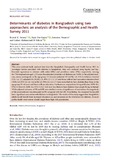| dc.contributor.author | Swasey, Krystal K. | |
| dc.contributor.author | Gupta, Rajat Das | |
| dc.contributor.author | Nayeem, Jannatun | |
| dc.contributor.author | Al Kibria, Gulam Muhammed | |
| dc.date.accessioned | 2022-04-05T05:44:58Z | |
| dc.date.available | 2022-04-05T05:44:58Z | |
| dc.date.copyright | 2019 | |
| dc.date.issued | 2019-10-21 | |
| dc.identifier.citation | Swasey, K., Gupta, R., Nayeem, J., & Kibria, G. (2020). Determinants of diabetes in Bangladesh using two approaches: An analysis of the Demographic and Health Survey 2011. Journal of Biosocial Science, 52(4), 585-595. doi:10.1017/S002193201900066X | en_US |
| dc.identifier.uri | http://hdl.handle.net/10361/16521 | |
| dc.description | This article was published in The Journal of Biosocial Science [ © Cambridge University Press 2019] and the definite version is available at: https://doi.org/10.1017/S002193201900066X. The Journal's website is at: https://www.cambridge.org/core/journals/journal-of-biosocial-science/article/determinants-of-diabetes-in-bangladesh-using-two-approaches-an-analysis-of-the-demographic-and-health-survey-2011/79E90A6DD9A7AE17C3E1E9662CEF58AD | en_US |
| dc.description.abstract | This cross-sectional study analysed data from the Bangladesh Demographic and Health Survey 2011 to investigate factors associated with diabetes in Bangladesh. Data were analysed using logistic and log-binomial regressions to estimate odds ratios (ORs) and prevalence ratios (PRs), respectively. Among the 7544 respondents aged ≥35 years, the estimated prevalence of diabetes was 11.0%. In the adjusted analysis, survey participants in the age group 55–64 years (adjusted PR [APR]: 1.8, 95% Confidence Interval (CI): 1.4, 2.2; adjusted OR [AOR]: 1.9, 95% CI: 1.5, 2.5) and those with at least secondary education level (APR: 1.3, 95% CI: 1.0, 1.6; AOR: 1.3, 95% CI: 1.0, 1.7) were more likely to have diabetes than those in the age group 35–44 years and those with no education. Furthermore, respondents living in Khulna (APR: 0.5, 95% CI: 0.4, 0.6; AOR: 0.4, 95% CI: 0.3, 0.6) were less likely to have diabetes than people living in Barisal. While adjusted estimates of PR and OR were similar in terms of significance of association, the magnitude of the point estimate was attenuated in PR compared with the OR. Nevertheless, the measured factors still had a significant association with diabetes in Bangladesh. The results of this study suggest that Bangladeshi adults would benefit from increased education on, and awareness of, the risk factors for diabetes. Focused public health intervention should target these high-risk populations. | en_US |
| dc.language.iso | en_US | en_US |
| dc.publisher | Cambridge University Press | en_US |
| dc.relation.uri | https://www.cambridge.org/core/journals/journal-of-biosocial-science/article/determinants-of-diabetes-in-bangladesh-using-two-approaches-an-analysis-of-the-demographic-and-health-survey-2011/79E90A6DD9A7AE17C3E1E9662CEF58AD | |
| dc.subject | Diabetes | en_US |
| dc.subject | Determinants | en_US |
| dc.subject | Bangladesh | en_US |
| dc.title | Determinants of diabetes in Bangladesh using two approaches: An analysis of the Demographic and Health Survey 2011 | en_US |
| dc.type | Journal Article | en_US |
| dc.description.version | Published | |
| dc.contributor.department | Brac James P. Grant School of Public Health | |
| dc.identifier.doi | https://doi.org/10.1017/S002193201900066X | |
| dc.relation.journal | Journal of Biosocial Science | |

